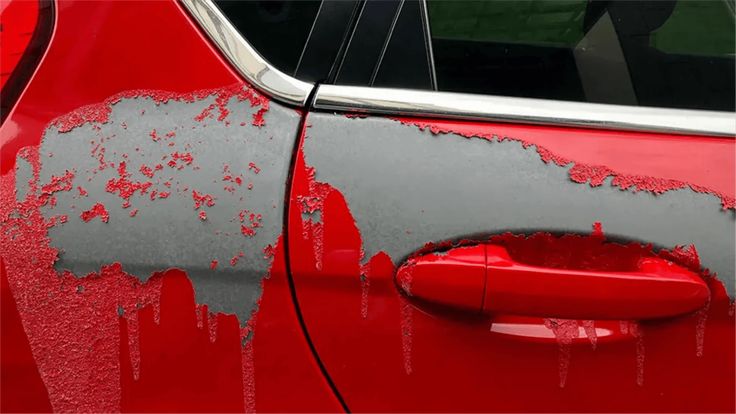Repair instructions
Oxidizing Paint on Car: Causes and How to Fix It
If your car’s paint looks dull or discolored, it could be suffering from oxidation. This chemical process occurs when your vehicle’s paint is exposed to harsh environmental conditions and lacks proper maintenance. Oxidation not only affects the aesthetics but also weakens the paint, making it more susceptible to rust. Fortunately, you can restore your car’s paint with the right techniques and products.
1. Is Oxidizing Paint Bad for My Car?
Yes, oxidation is harmful to your vehicle. While it won’t impact performance, it can severely affect your car’s appearance, lowering its resale value. Over time, oxidation can degrade the paint enough to expose the metal underneath, which increases the risk of rust formation.
Eventually, untreated oxidation can cause the paint to flake and peel, giving your car a neglected, worn-out look.

2. What Causes Car Paint to Oxidize?
Several factors contribute to the oxidation of car paint. The most common culprits include:
2.1. Exposure to Sunlight
The sun’s ultraviolet (UV) rays break down the chemical bonds in your paint, leading to fading, loss of shine, and eventual oxidation.
2.2. Contamination
Environmental contaminants like bird droppings, tree sap, and pollutants can damage the paint surface, making it more prone to oxidation. Humidity and rain can also exacerbate the issue, accelerating corrosion.
2.3. Road Salt
Salt used to melt snow and ice can cause serious damage to your car’s paint, especially if not washed off promptly. Coastal areas with salty air can also increase the risk of oxidation.
2.4. Poor Maintenance
Neglecting to clean and wax your car regularly leaves the paint vulnerable to oxidation. Regular maintenance is key to preserving your car’s finish and protecting it from the elements.
3. How to Remove Oxidation from Car Paint
If your car’s paint is showing signs of oxidation, you can restore its shine with the right techniques and products. Here’s how to do it:
3.1. What You’ll Need
Before starting, make sure you have the following tools and products:
- A bucket of water
- Car shampoo or cleaning solution
- Sponge
- Microfiber cloth
- Polishing compound
- Rubbing compound (for heavy oxidation)
- Polisher with foam pads
- Car wax or paint sealant
3.2. Steps to Remove Oxidation
- Wash Your Vehicle Start by thoroughly washing your car using a car shampoo or cleaning solution. Rinse from top to bottom, ensuring all dirt and debris are removed. Dry the surface with a microfiber cloth to avoid scratches.
- Use a Clay Bar After washing, use a clay bar to remove any remaining contaminants, such as embedded dirt or light oxidation. This step ensures the paint is as clean as possible before polishing.
- Apply a Polishing Compound If your car’s oxidation is light, apply a polishing compound using a foam pad and a polisher. Use light pressure and work on small sections at a time to restore the paint’s shine and color.
- Use a Rubbing Compound (If Necessary) For more severe oxidation, you’ll need a rubbing compound. This compound is more abrasive and will help remove deeper oxidation. Be cautious and use it sparingly to avoid damaging the paint.
- Wax Your Car After removing the oxidation, apply a layer of wax or paint sealant to protect the finish. Waxing will create a protective barrier that helps prevent future oxidation and keeps your car’s paint looking fresh.
4. How to Prevent Paint Oxidation
Preventing oxidation is much easier than fixing it. Here are some effective ways to keep your car’s paint in top condition:
4.1. Wash and Wax Your Vehicle Regularly
Regular cleaning removes dirt and contaminants that could lead to oxidation. It’s recommended to wash your car every 2-3 weeks and wax it every 3 months to maintain protection.
4.2. Park in Shaded Areas
Minimize exposure to UV rays by parking in shaded areas or under a roof. This will help protect the paint from fading and oxidation caused by the sun.
4.3. Get Ceramic Paint Coating
For long-term protection, consider a ceramic paint coating. These coatings provide a durable, glossy finish that resists UV rays, chemicals, and oxidation. Ceramic coatings bond chemically with your car’s paint, offering a superior protective layer.
By following these steps and maintaining a regular cleaning and waxing routine, you can prevent oxidation and keep your car’s paint looking brand new for years to come. If the damage is too severe, you may need to consult a professional for repainting or touch-ups.
